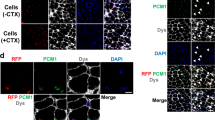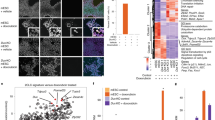Abstract
Spinal muscular atrophy is one of the most common inherited forms of neurological disease leading to infant mortality. Patients have selective loss of lower motor neurons resulting in muscle weakness, paralysis and often death. Although patient fibroblasts have been used extensively to study spinal muscular atrophy, motor neurons have a unique anatomy and physiology which may underlie their vulnerability to the disease process. Here we report the generation of induced pluripotent stem cells from skin fibroblast samples taken from a child with spinal muscular atrophy. These cells expanded robustly in culture, maintained the disease genotype and generated motor neurons that showed selective deficits compared to those derived from the child’s unaffected mother. This is the first study to show that human induced pluripotent stem cells can be used to model the specific pathology seen in a genetically inherited disease. As such, it represents a promising resource to study disease mechanisms, screen new drug compounds and develop new therapies.
This is a preview of subscription content, access via your institution
Access options
Subscribe to this journal
Receive 51 print issues and online access
$199.00 per year
only $3.90 per issue
Buy this article
- Purchase on Springer Link
- Instant access to full article PDF
Prices may be subject to local taxes which are calculated during checkout




Similar content being viewed by others
References
Lefebvre, S. et al. Identification and characterization of a spinal muscular atrophy-determining gene. Cell 80, 155–165 (1995)
Coovert, D. D. et al. The survival motor neuron protein in spinal muscular atrophy. Hum. Mol. Genet. 6, 1205–1214 (1997)
Crawford, T. O. & Pardo, C. A. The neurobiology of childhood spinal muscular atrophy. Neurobiol. Dis. 3, 97–110 (1996)
Munsat, T. L. & Davies, K. E. International SMA consortium meeting. (26–28 June 1992, Bonn, Germany). Neuromuscul. Disord. 2, 423–428 (1992)
Lorson, C. L., Hahnen, E., Androphy, E. J. & Wirth, B. A single nucleotide in the SMN gene regulates splicing and is responsible for spinal muscular atrophy. Proc. Natl Acad. Sci. USA 96, 6307–6311 (1999)
Lefebvre, S. et al. Correlation between severity and SMN protein level in spinal muscular atrophy. Nature Genet. 16, 265–269 (1997)
Schmid, A. & DiDonato, C. J. Animal models of spinal muscular atrophy. J. Child Neurol. 22, 1004–1012 (2007)
Schrank, B. et al. Inactivation of the survival motor neuron gene, a candidate gene for human spinal muscular atrophy, leads to massive cell death in early mouse embryos. Proc. Natl Acad. Sci. USA 94, 9920–9925 (1997)
DiDonato, C. J. et al. Cloning, characterization, and copy number of the murine survival motor neuron gene: homolog of the spinal muscular atrophy-determining gene. Genome Res. 7, 339–352 (1997)
Hsieh-Li, H. M. et al. A mouse model for spinal muscular atrophy. Nature Genet. 24, 66–70 (2000)
Monani, U. R. et al. The human centromeric survival motor neuron gene (SMN2) rescues embryonic lethality in Smn-/- mice and results in a mouse with spinal muscular atrophy. Hum. Mol. Genet. 9, 333–339 (2000)
Le, T. T. et al. SMNΔ7, the major product of the centromeric survival motor neuron (SMN2) gene, extends survival in mice with spinal muscular atrophy and associates with full-length SMN. Hum. Mol. Genet. 14, 845–857 (2005)
Park, I. H. et al. Reprogramming of human somatic cells to pluripotency with defined factors. Nature 451, 141–146 (2008)
Jaenisch, R. & Young, R. Stem cells, the molecular circuitry of pluripotency and nuclear reprogramming. Cell 132, 567–582 (2008)
Takahashi, K. et al. Induction of pluripotent stem cells from adult human fibroblasts by defined factors. Cell 131, 861–872 (2007)
Yu, J. et al. Induced pluripotent stem cell lines derived from human somatic cells. Science 318, 1917–1920 (2007)
Lowry, W. E. et al. Generation of human induced pluripotent stem cells from dermal fibroblasts. Proc. Natl Acad. Sci. USA 105, 2883–2888 (2008)
Dimos, J. T. et al. Induced pluripotent stem cells generated from patients with ALS can be differentiated into motor neurons. Science 321, 1218–1221 (2008)
Park, I. H. et al. Disease-specific induced pluripotent stem cells. Cell 134, 877–886 (2008)
Jakel, R. J., Schneider, B. L. & Svendsen, C. N. Using human neural stem cells to model neurological disease. Nature Rev. Genet. 5, 136–144 (2004)
Gavrilov, D. K., Shi, X. Y., Das, K., Gilliam, T. C. & Wang, C. H. Differential SMN2 expression associated with SMA severity. Nature Genet. 20, 230–231 (1998)
Sumner, C. J. et al. SMN mRNA and protein levels in peripheral blood: biomarkers for SMA clinical trials. Neurology 66, 1067–1073 (2006)
Fox, V. et al. Cell-cell signaling through NOTCH regulates human embryonic stem cell proliferation. Stem Cells 26, 715–723 (2008)
Svendsen, C. N. et al. A new method for the rapid and long term growth of human neural precursor cells. J. Neurosci. Methods 85, 141–152 (1998)
Lendahl, U., Zimmerman, L. B. & McKay, R. D. G. Cns stem-cells express a new class of intermediate filament protein. Cell 60, 585–595 (1990)
Li, X. J. et al. Specification of motoneurons from human embryonic stem cells. Nature Biotechnol. 23, 215–221 (2005)
Jessell, T. M. Neuronal specification in the spinal cord: Inductive signals and transcriptional codes. Nature Rev. Genet. 1, 20–29 (2000)
Wichterle, H., Lieberam, I., Porter, J. A. & Jessell, T. M. Directed differentiation of embryonic stem cells into motor neurons. Cell 110, 385–397 (2002)
Carriedo, S. G., Yin, H. Z. & Weiss, J. H. Motor neurons are selectively vulnerable to AMPA/kainate receptor-mediated injury in vitro . J. Neurosci. 16, 4069–4079 (1996)
Monani, U. R. Spinal muscular atrophy: a deficiency in a ubiquitous protein; a motor neuron-specific disease. Neuron 48, 885–896 (2005)
Brichta, L. et al. Valproic acid increases the SMN2 protein level: a well-known drug as a potential therapy for spinal muscular atrophy. Hum. Mol. Genet. 12, 2481–2489 (2003)
Sumner, C. J. et al. Valproic acid increases SMN levels in spinal muscular atrophy patient cells. Ann. Neurol. 54, 647–654 (2003)
Wolstencroft, E. C., Mattis, V., Bajer, A. A., Young, P. J. & Lorson, C. L. A non-sequence-specific requirement for SMN protein activity: the role of aminoglycosides in inducing elevated SMN protein levels. Hum. Mol. Genet. 14, 1199–1210 (2005)
Pellizzoni, L., Yong, J. & Dreyfuss, G. Essential role for the SMN complex in the specificity of snRNP assembly. Science 298, 1775–1779 (2002)
Fischer, U., Liu, Q. & Dreyfuss, G. The SMN–SIP1 complex has an essential role in spliceosomal snRNP biogenesis. Cell 90, 1023–1029 (1997)
Liu, Q., Fischer, U., Wang, F. & Dreyfuss, G. The spinal muscular atrophy disease gene product, SMN, and its associated protein SIP1 are in a complex with spliceosomal snRNP proteins. Cell 90, 1013–1021 (1997)
Carrel, T. L. et al. Survival motor neuron function in motor axons is independent of functions required for small nuclear ribonucleoprotein biogenesis. J. Neurosci. 26, 11014–11022 (2006)
Zhang, H. et al. Multiprotein complexes of the survival of motor neuron protein SMN with gemins traffic to neuronal processes and growth cones of motor neurons. J. Neurosci. 26, 8622–8632 (2006)
Bolstad, B. M., Irizarry, R. A., Astrand, M. & Speed, T. P. A comparison of normalization methods for high density oligonucleotide array data based on variance and bias. Bioinformatics 19, 185–193 (2003)
Irizarry, R. A. et al. Exploration, normalization, and summaries of high density oligonucleotide array probe level data. Biostatistics 4, 249–264 (2003)
Suzuki, R. & Shimodaira, H. Pvclust: an R package for assessing the uncertainty in hierarchical clustering. Bioinformatics 22, 1540–1542 (2006)
Acknowledgements
We thank J. Meyer for helpful discussions and B. Shelley, B. Heins and E. McMillan for technical assistance. We also thank WiCell Research Institute for karyotype analysis, Cell Line Genetics for DNA fingerprinting, R. Stewart, S. Tian and V. Ruotti at the Morgridge Institute for Research for microarray analysis, and Promega Corp. for qRT–PCR analysis (all at Madison, Wisconsin). The MNR2/HB9 (81.5C10) and the ISLET1 (40.2D6) monoclonal antibodies (both developed by T. Jessell) were obtained from the Developmental Studies Hybridoma Bank. Funding support was provided by the Amyotrophic Lateral Sclerosis Association (to C.N.S.), the National Institutes of Neurological Disorders and Stroke (P01NS057778 to C.N.S. and R01NS41584 to C.L.L.), National Institutes of Child Health and Human Development (R01HD054413 to C.L.L.), and National Institutes of General Medical Sciences (T32GM008396 for F.F.R.).
Author Contributions A.D.E. participated in all aspects and prepared the manuscript; J.Y. generated and aided in the characterization of iPS-SMA and iPS-WT clones; F.F.R., V.B.M. and C.L.L. performed SMN analysis and manuscript preparation; J.A.T. participated in the generation of the iPS clones; C.N.S. conceived the project and participated in planning, data analysis and manuscript preparation.
Author information
Authors and Affiliations
Corresponding authors
Supplementary information
Supplementary Information
This file contains Supplementary Figures 1-7 with Legends and Supplementary Tables 1-3 (PDF 2790 kb)
Rights and permissions
About this article
Cite this article
Ebert, A., Yu, J., Rose, F. et al. Induced pluripotent stem cells from a spinal muscular atrophy patient. Nature 457, 277–280 (2009). https://doi.org/10.1038/nature07677
Received:
Accepted:
Published:
Issue Date:
DOI: https://doi.org/10.1038/nature07677
This article is cited by
-
Generation of human iPSC-derived phrenic-like motor neurons to model respiratory motor neuron degeneration in ALS
Communications Biology (2024)
-
NeuroLINCS Proteomics: Defining human-derived iPSC proteomes and protein signatures of pluripotency
Scientific Data (2023)
-
“Cutting the Mustard” with Induced Pluripotent Stem Cells: An Overview and Applications in Healthcare Paradigm
Stem Cell Reviews and Reports (2022)
-
Viral vector gene delivery of the novel chaperone protein SRCP1 to modify insoluble protein in in vitro and in vivo models of ALS
Gene Therapy (2021)
-
Approaches to characterize the transcriptional trajectory of human myogenesis
Cellular and Molecular Life Sciences (2021)
Comments
By submitting a comment you agree to abide by our Terms and Community Guidelines. If you find something abusive or that does not comply with our terms or guidelines please flag it as inappropriate.



